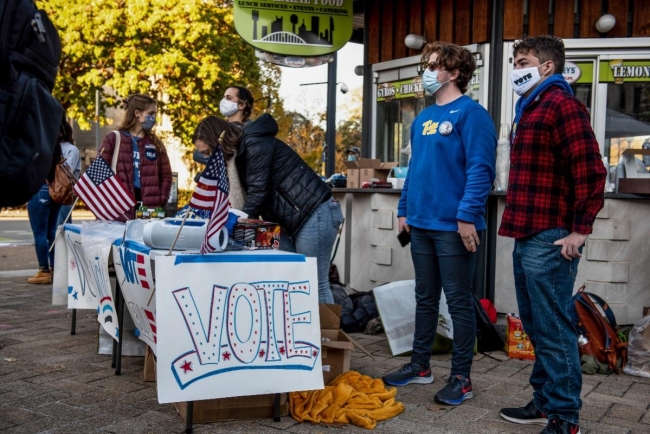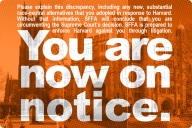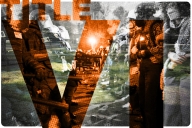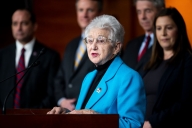You have /5 articles left.
Sign up for a free account or log in.

Aaron Jackendoff/Getty Images
Student voting organizations are gearing up to capitalize on the high youth voter turnout for the 2020 elections and spur students to participate in this year’s local and state elections. Among the highest-profile races for 2021: gubernatorial contests in Virginia and New Jersey, special House elections such as Ohio’s 11th District, and the recall vote of California governor Gavin Newsom in September.
But will students participate? Kelly Beadle, the impact and outreach manager of the Center for Information and Research on Civic Learning and Engagement (CIRCLE) at Tufts University, said that youth turnout for upcoming elections “remains an open question.”
“We have always seen that turnout of all people, including youth, is lower in state elections,” Beadle said.
Her organization, which focuses on youth civic engagement in the U.S., saw historic voter participation of 18- to 29-year-olds in the 2020 election. New Jersey had the highest youth turnout in the country, with 67 percent of those between 18 and 29 casting ballots. The state’s turnout rate for 18- to 19-year-olds, who were mostly voting for the first time, was 65 percent.
Beadle credits the state’s "proactive" tactics -- which included implementing automatic voter registration at motor vehicle agencies and sending ballots to every registered voter -- for boosting youth turnout.
“Institutionalizing proactive measures, which are so important for young people, who are moving more frequently and who may need reminders to update their registration because of their mobility rates, are the types of things we’re starting to see are correlated with higher voter turnout,” Beadle said.
The push to sustain high youth voter turnout coincides with efforts by congressional Democrats to pass two bills that would standardize voting across the nation. The For the People Act, also known as HR 1, is centered around voter access, election integrity and security, campaign finance, and government ethics. It aims to improve voter access and standardize voter registration nationwide, which could be consequential for college students and young voters.
“There’s a lot of elements in that bill that we think are correlated with higher youth voter turnout,” Beadle said. “Our opinion is that that would have a positive impact on students.”
This week, the House passed a second bill: the John Lewis Voting Rights Advancement Act, which seeks to reinstate the oversight power of the Voting Rights Act, reviving the power of the Justice Department to bar some discriminatory changes to election procedures.
Carolyn DeWitt, president of Rock the Vote, a nonpartisan nonprofit dedicated to building the political power of young people, said both bills are an “opportunity to ensure that we can protect our democracy and protect against discrimination.”
This year Rock the Vote expanded its email and text election-reminder program to include important dates and deadlines for municipal and local elections in the top 500 most populous cities. The organization also created Democracy Class, a free, nonpartisan curriculum that educates Atlanta high school students about the history of voting and registers them to vote. According to DeWitt, the organization’s main goal is to educate youth about voting and empower them to speak with their peers, with a focus on using social media as a tool.
“We know that we’re not the biggest influencer,” DeWitt said. “For a lot of young people, it’s actually their peers who are empowering young people to reach out to their friends and family with the informational resources that they need to be engaged in.”
Campus Vote Project, a project of the Fair Elections Center that works with institutions, students and election officials to reduce barriers to student voting, has voiced its support for both the For the People Act and the John Lewis Voting Rights Advancement Act. Madeline Doane, the organization’s Virginia state coordinator, said both pieces of legislation are vital.
“We’re big proponents of everything to make voting more accessible,” Doane said. “It would really standardize the procedure for folks being able to register, which is incredibly important, since there’re currently so many hoops that students have to jump through if they’re out of state.”
Doane works with the CVP’s Democracy Fellows, students who engage with and educate their peers about voting, to create innovative events such as town halls and candidate forums that are especially tailored to students without much knowledge of politics.
“Rather than just giving blanket information to people, we’re really figuring out what their passions are and how we can meet them where they’re at,” Doane said. “In that same vein, we’re trying to figure out how to make these events in off years, in general, more interesting.”
To take one example, in April, CVP hosted a Virginia Democracy Summit, a two-day virtual event that focused on building inclusive, accessible and equitable coalitions and communities involved in voter engagement efforts, Doane said. Attendees discussed digital and community organizing and redistricting and identified barriers to civic engagement on college campuses. This fall CVP plans to hold another Virginia Democracy Summit on student power in local elections. Sessions, which will be conducted both virtually and in person at Virginia Commonwealth University, will focus on celebrating the 26th Amendment, preparing for civic holidays to strengthen voter participation and more.
Youth voter turnout in Virginia doubled between 2009 and 2017, CIRCLE’s Beadle said, and it surged in the 2017 gubernatorial election. About 366,000 young people voted in the state’s 2017 election, accounting for 34 percent of all eligible young voters -- eight percentage points higher than the turnout rate in 2013.
Chiara Grimes, a political science student at Northern Virginia Community College who served as a Democracy Fellow and now sits on CVP’s Student Advisory Board, said the organization favors a more localized approach. Students know their own campus culture better than outsiders, and they understand the best way to reach their classmates, whether it’s through informational briefings or social media platforms like Instagram and Tik Tok, she said.
“It’s really easy to see for each individual campus what needs to be done and what students can do to engage their fellow students to go out and vote,” Grimes said.
In California, students are preparing to register other students for the September recall vote of Newsom. Sarah Wang, external vice president of University of California, Los Angeles’s Undergraduate Students Association, said her organization is working to increase voter turnout on campus.
“We’ve really struggled with voter engagement, not only within our own student government elections, but also in actual city council, state or even national races,” Wang said. “So my office is going to try to be picking up on the momentum that hybrid and virtual lobbying has given us.”
Wang said her student government is using the virtual meetings necessitated by COVID as an opportunity to speak with representatives about HR 1 and other priorities students have.
Registered voters in California are receiving mail-in ballots to determine Newsom’s future, after more than 1.6 million Californians signed an initial petition demanding his recall. With the voter registration deadline on Aug. 30 and Election Day on Sept. 14, Wang said her organization’s top priority is to educate students on what’s on the ballot and how they can vote. Her Instagram account, which has thousands of followers, provides detailed information for the upcoming recall vote.
“We’re trying to reach people wherever they are on digital platforms,” Wang said.
Beadle said the same vote-by-mail processes that bolstered turnout in the 2020 election would lead to higher youth turnout for the recall vote.
“Youth need more assistance generally in participating in elections because they need to re-register and they need to often vote at different places each election year,” Beadle said. “So the combination of what the state does and what campaigns do will greatly inform that.”
Voter turnout in California increased “a lot” between 2016 and 2020, Beadle said. Turnout for 18- to 29-year-olds reached 54 percent, according to CIRCLE, and 57 percent for 18- to 19-year-olds alone.
“For being a noncompetitive swing state, to have turnout as high as it was among youth in 2020 was pretty surprising to us,” Beadle said.
Given that more than 31,000 undergraduates attend UCLA, it’s been difficult to reach every student, Wang said. In addition to relying on social media and email blasts, UCLA’s student government is “paying thousands of dollars” to have a polling place on campus, she said. Additionally, the university has a permanent drop box where students can deposit ballots.
“We’re optimistic that we can make an impact and definitely increase awareness,” Wang said. “But it’s really tough for us because the election is on the 14th and we don’t start school until the 23rd … It’s just a matter of how many students will be in the area that early, especially with COVID.”
The Students Learn Students Vote Coalition, a nonpartisan network dedicated to increasing college student voter participation, has programs nationwide to mobilize students to vote. Eddy Zerbe, the coalition’s special projects director, helps run Campus Takeover, which aims to mobilize students during civic holidays, like National Voter Registration Day on Sept. 28. In 2020, Campus Takeover distributed $50,000 to campuses around the nation to celebrate National Voter Registration Day, Zerbe said. This year the organization hopes to distribute another $50,000 in partnership with the Alliance for Youth Organizing.
“You’ve seen historically high voter registration and voter turnout rates from young people that have just been continuously building over the last couple of years,” Zerbe said. “And what we’re doing this year is really trying to build on that success.”
SLSV is comprised of more than 400 nonpartisan organizations that collectively work on nearly 2,000 college campuses. Carmen Liñero-Lopez is an SLSV program manager for Ask Every Student, a joint initiative that facilitates collaboration between campus leaders and nonprofit partners to provide funding, trainings, newsletters and open discussions to boost student engagement in the voting process.
“This year we’re focusing on accessibility and, for 2022, building our network out in more and more states,” Liñero-Lopez said. “Just because it’s an odd year doesn’t mean there’s not really important elections happening everywhere, even in places that don’t get a lot of attention from traditional stakeholders.”
As more campuses partner with SLSV and other student voter organizations, Zerbe said, a main part of the work is to make sure enthusiasm for civic engagement remain a "constant presence on campus" even when it is an odd election year.
"More and more higher education institutions are getting into this work, and we’re making it easy for them to be able to continue that trend," Zerbe said. "Once they get their foot in the door, we’re here to help them take that work to the next level, by either helping them celebrate civic holidays or integrate voter registration into their student orientation practices."








